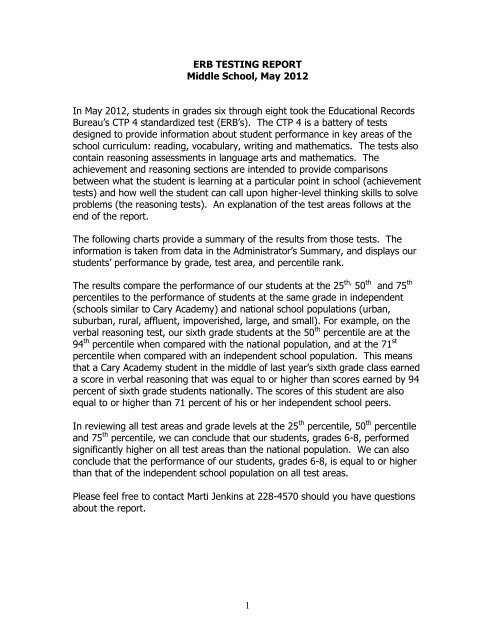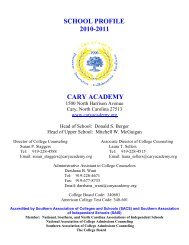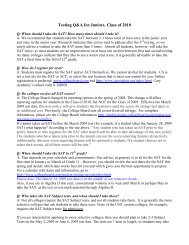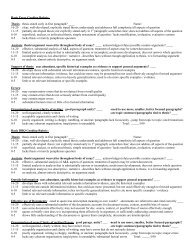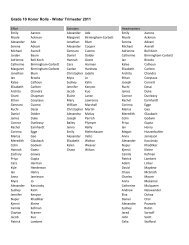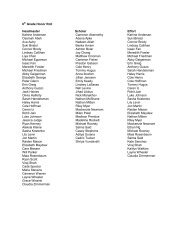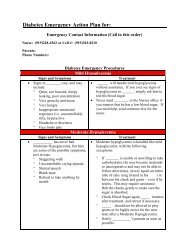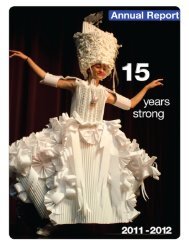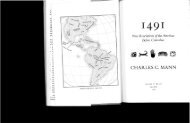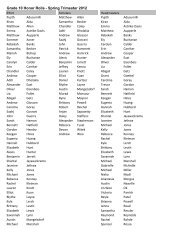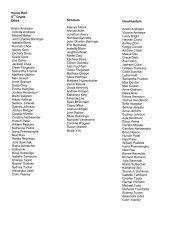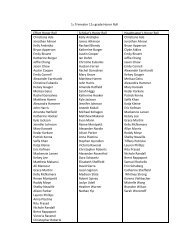ERB TESTING REPORT - Cary Academy
ERB TESTING REPORT - Cary Academy
ERB TESTING REPORT - Cary Academy
Create successful ePaper yourself
Turn your PDF publications into a flip-book with our unique Google optimized e-Paper software.
<strong>ERB</strong> <strong>TESTING</strong> <strong>REPORT</strong><br />
Middle School, May 2012<br />
In May 2012, students in grades six through eight took the Educational Records<br />
Bureau’s CTP 4 standardized test (<strong>ERB</strong>’s). The CTP 4 is a battery of tests<br />
designed to provide information about student performance in key areas of the<br />
school curriculum: reading, vocabulary, writing and mathematics. The tests also<br />
contain reasoning assessments in language arts and mathematics. The<br />
achievement and reasoning sections are intended to provide comparisons<br />
between what the student is learning at a particular point in school (achievement<br />
tests) and how well the student can call upon higher-level thinking skills to solve<br />
problems (the reasoning tests). An explanation of the test areas follows at the<br />
end of the report.<br />
The following charts provide a summary of the results from those tests. The<br />
information is taken from data in the Administrator’s Summary, and displays our<br />
students’ performance by grade, test area, and percentile rank.<br />
The results compare the performance of our students at the 25 th, 50 th and 75 th<br />
percentiles to the performance of students at the same grade in independent<br />
(schools similar to <strong>Cary</strong> <strong>Academy</strong>) and national school populations (urban,<br />
suburban, rural, affluent, impoverished, large, and small). For example, on the<br />
verbal reasoning test, our sixth grade students at the 50 th percentile are at the<br />
94 th percentile when compared with the national population, and at the 71 st<br />
percentile when compared with an independent school population. This means<br />
that a <strong>Cary</strong> <strong>Academy</strong> student in the middle of last year’s sixth grade class earned<br />
a score in verbal reasoning that was equal to or higher than scores earned by 94<br />
percent of sixth grade students nationally. The scores of this student are also<br />
equal to or higher than 71 percent of his or her independent school peers.<br />
In reviewing all test areas and grade levels at the 25 th percentile, 50 th percentile<br />
and 75 th percentile, we can conclude that our students, grades 6-8, performed<br />
significantly higher on all test areas than the national population. We can also<br />
conclude that the performance of our students, grades 6-8, is equal to or higher<br />
than that of the independent school population on all test areas.<br />
Please feel free to contact Marti Jenkins at 228-4570 should you have questions<br />
about the report.<br />
1
Sixth Grade <strong>ERB</strong> Results – Spring 2012<br />
*PERCENTILE RANKS<br />
TEST AREA CARY ACADEMY INDEPENDENT NATIONAL<br />
V<strong>ERB</strong>AL REASONING 25 56 88<br />
VOCABULARY 25 42 90<br />
READING COMPREHENSION 25 51 81<br />
WRITING MECHANICS 25 44 88<br />
WRITING CONCEPTS AND SKILLS 25 54 91<br />
QUANTITATIVE REASONING 25 59 91<br />
MATHEMATICS 1 & 2 25 60 85<br />
*PERCENTILE RANKS<br />
TEST AREA CARY ACADEMY INDEPENDENT NATIONAL<br />
V<strong>ERB</strong>AL REASONING 50 71 94<br />
VOCABULARY 50 68 96<br />
READING COMPREHENSION 50 71 95<br />
WRITING MECHANICS 50 64 94<br />
WRITING CONCEPTS AND SKILLS 50 71 96<br />
QUANTITATIVE REASONING 50 72 95<br />
MATHEMATICS 1 & 2 50 75 92<br />
*PERCENTILE RANKS<br />
TEST AREA CARY ACADEMY INDEPENDENT NATIONAL<br />
V<strong>ERB</strong>AL REASONING 75 86 99<br />
VOCABULARY 75 81 98<br />
READING COMPREHENSION 75 90 99<br />
WRITING MECHANICS 75 86 98<br />
WRITING CONCEPTS AND SKILLS 75 86 98<br />
QUANTITATIVE REASONING 75 88 98<br />
MATHEMATICS 1 & 2 75 89 97<br />
*Percentile rank is the percentage of students in the norm sample whose scores fall at or below a<br />
given score. A percentile rank indicates a student’s relative standing in a norming sample, it does<br />
not indicate the score itself. The 50 th percentile corresponds to the median, and indicates that a<br />
student scored higher than half of the sample and lower than the other half.<br />
2
SEVENTH GRADE <strong>ERB</strong> RESULTS – SPRING 2012<br />
*PERCENTILE RANKS<br />
TEST AREA CARY ACADEMY INDEPENDENT NATIONAL<br />
V<strong>ERB</strong>AL REASONING 25 54 90<br />
VOCABULARY 25 46 88<br />
READING COMPREHENSION 25 45 79<br />
WRITING MECHANICS 25 47 87<br />
WRITING CONCEPTS AND SKILLS 25 42 87<br />
QUANTITATIVE REASONING 25 53 93<br />
MATHEMATICS 1 & 2 25 60 94<br />
*PERCENTILE RANKS<br />
TEST AREA CARY ACADEMY INDEPENDENT NATIONAL<br />
V<strong>ERB</strong>AL REASONING 50 72 94<br />
VOCABULARY 50 68 95<br />
READING COMPREHENSION 50 66 88<br />
WRITING MECHANICS 50 64 93<br />
WRITING CONCEPTS AND SKILLS 50 59 93<br />
QUANTITATIVE REASONING 50 75 98<br />
MATHEMATICS 1 & 2 50 81 98<br />
*PERCENTILE RANKS<br />
TEST AREA CARY ACADEMY INDEPENDENT NATIONAL<br />
V<strong>ERB</strong>AL REASONING 75 88 98<br />
VOCABULARY 75 87 99<br />
READING COMPREHENSION 75 84 95<br />
WRITING MECHANICS 75 87 98<br />
WRITING CONCEPTS AND SKILLS 75 82 97<br />
QUANTITATIVE REASONING 75 86 99<br />
MATHEMATICS 1 & 2 75 91 99<br />
*Percentile rank is the percentage of students in the norm sample whose scores fall at or below<br />
a given score. A percentile rank indicates a student’s relative standing in a norming sample, it<br />
does not indicate the score itself. The 50 th percentile corresponds to the median, and indicates<br />
that a student scored higher than half of the sample and lower than the other half.<br />
3
EIGHTH GRADE <strong>ERB</strong> RESULTS – SPRING 2012<br />
*PERCENTILE RANKS<br />
TEST AREA CARY ACADEMY INDEPENDENT NATIONAL<br />
V<strong>ERB</strong>AL REASONING 25 52 92<br />
VOCABULARY 25 47 89<br />
READING COMPREHENSION 25 48 88<br />
WRITING MECHANICS 25 58 92<br />
WRITING CONCEPTS AND SKILLS 25 54 89<br />
QUANTITATIVE REASONING 25 59 94<br />
MATHEMATICS 1 & 2 25 68 96<br />
*PERCENTILE RANKS<br />
TEST AREA CARY ACADEMY INDEPENDENT NATIONAL<br />
V<strong>ERB</strong>AL REASONING 50 72 97<br />
VOCABULARY 50 66 95<br />
READING COMPREHENSION 50 68 94<br />
WRITING MECHANICS 50 75 97<br />
WRITING CONCEPTS AND SKILLS 50 76 95<br />
QUANTITATIVE REASONING 50 79 97<br />
MATHEMATICS 1 & 2 50 82 98<br />
*PERCENTILE RANKS<br />
TEST AREA CARY ACADEMY INDEPENDENT NATIONAL<br />
V<strong>ERB</strong>AL REASONING 75 87 99<br />
VOCABULARY 75 81 98<br />
READING COMPREHENSION 75 85 99<br />
WRITING MECHANICS 75 89 99<br />
WRITING CONCEPTS AND SKILLS 75 88 98<br />
QUANTITATIVE REASONING 75 90 99<br />
MATHEMATICS 1 & 2 75 91 99<br />
*Percentile rank is the percentage of students in the norm sample whose scores fall at or below a<br />
given score. A percentile rank indicates a student’s relative standing in a norming sample, it does<br />
not indicate the score itself. The 50 th percentile corresponds to the median, and indicates that a<br />
student scored higher than half of the sample and lower than the other half.<br />
4
Description of CTP 4 Achievement Tests<br />
Verbal Reasoning: the ability to analyze information and draw logical inferences, to<br />
recognize analogical verbal relationships, and to generalize verbal categorical attributes<br />
Auditory Comprehension: pre-reading vocabulary and comprehension of orally<br />
presented material, understanding of stated information, the ability to determine the gist<br />
of short passages, and the ability to infer information based on these passages<br />
Vocabulary: recognition and understanding of a wide range of grade-appropriate<br />
vocabulary and use of context clues to determine meaning<br />
Reading Comprehension: comprehension of written material, including recall of<br />
information, identifying of main ideas, and hypothesizing using information from<br />
passages<br />
Reading for Understanding: (with constructed-response questions): the ability to<br />
communicate understanding of explicit and implicit information presented in passages<br />
and the ability to compare and contrast explicit and implicit information from two related<br />
passages<br />
Writing Mechanics: understanding of spelling, capitalization, punctuation, and usage<br />
conventions<br />
Writing Concepts and Skills: understanding of the components of effective written<br />
composition<br />
Mathematics: conceptual understanding of mathematics, application of mathematical<br />
knowledge to solve problems, and the ability to compute or estimate solutions<br />
Mathematics (with constructed-response questions): the ability to communicate in the<br />
language of mathematics<br />
Quantitative Reasoning: the ability to analyze mathematical concepts and principles, to<br />
make generalizations, and to compare quantities mathematically<br />
Algebra I: skills typically taught in Algebra I with emphasis on problem solving and<br />
operations with variables, equations, and algebraic geometry<br />
5


